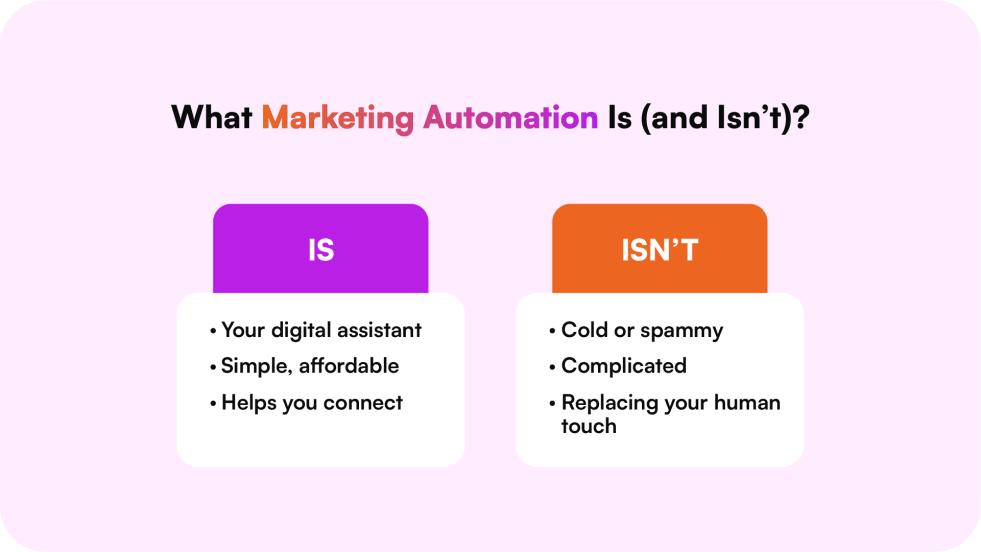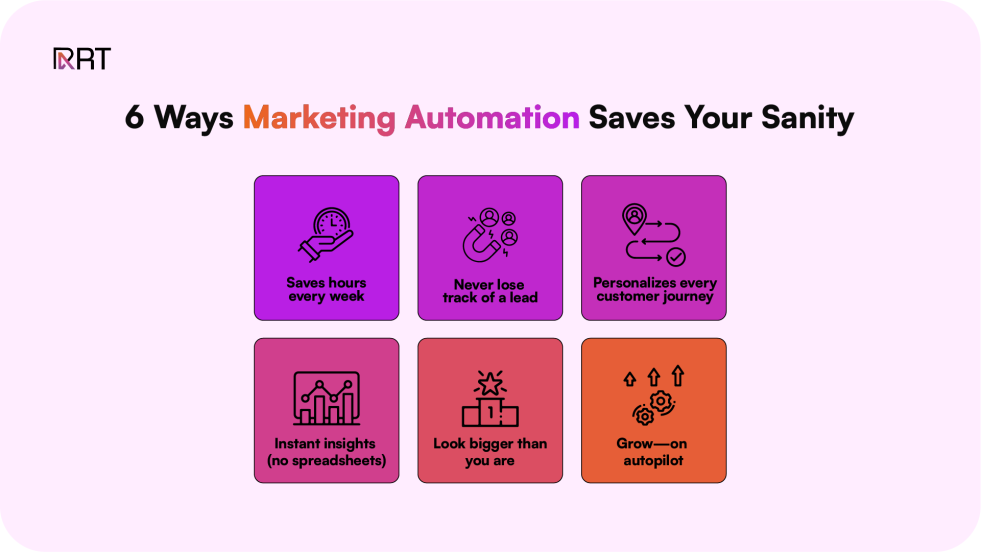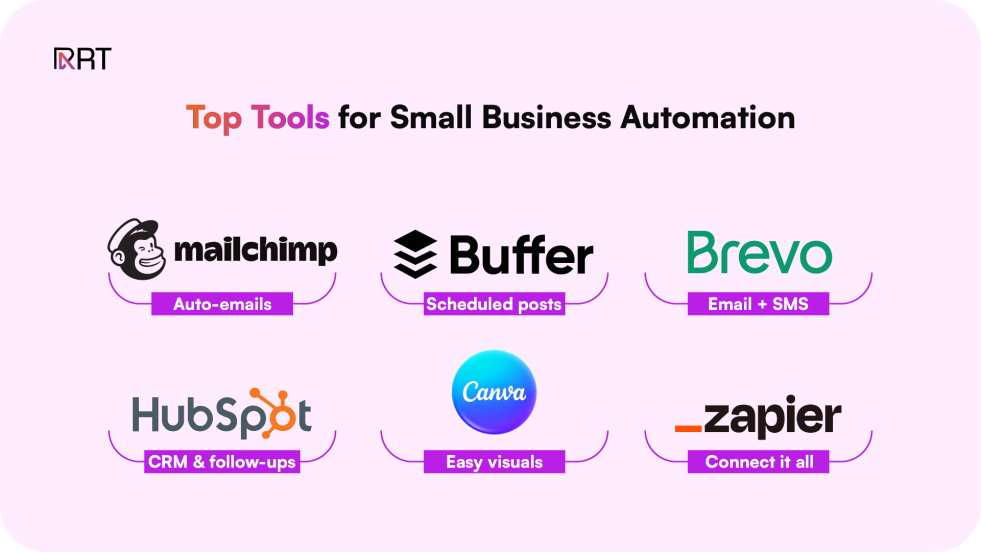Why Every Small Business Needs Marketing Automation?
Always busy but never caught up? Marketing automation takes the busywork off your plate so you can focus on what actually grows your business.
August 12, 2025

Ever catch yourself wishing there were more hours in the day? If you’re running a small business, you probably know the feeling all too well. There’s always one more email to send, one more post to schedule, one more customer to follow up with, and somehow, you’re expected to do it all, with a smile.
Meanwhile, your customers have high expectations. They want quick replies, personal touches, and the kind of attention that makes them feel like your only client. No pressure, right?
Now, imagine if you had a silent partner, someone who handles those repetitive, time-consuming marketing tasks, never takes a sick day, and frees you up to focus on what you love about your business. That’s not a fantasy. That’s marketing automation.
But let’s be honest: the word “automation” can sound a bit cold or technical, especially if you’re used to doing things the hands-on way. The truth? When done right, automation isn’t about replacing your human touch. It’s about helping you deliver more of it, to more people, with less stress.
So, before you write it off as a tool for the big players, take a minute to see how marketing automation can give even the smallest business a superpower, making your life easier, your customers happier, and your business stronger.
What Exactly Is Marketing Automation (And What Isn’t It)?
Let’s clear up the confusion right away, marketing automation isn’t some robot that suddenly takes over your business, nor is it an expensive gadget only tech giants can afford. Think of it more like your super-organized best friend: the one who remembers birthdays, never forgets to send a thank you note, and always follows up at just the right time.
At its core, marketing automation is simply using affordable, user-friendly tools to handle routine tasks, things like sending welcome emails, scheduling social media posts, or following up with leads automatically, so you don’t have to be glued to your laptop all day.

Here’s what it can look like for a small business:
- An email goes out to every new customer, welcoming them by name without you typing it out, ever.
- Your Instagram posts appear right on schedule, even if you’re busy running errands or meeting a client.
- Reminders, promotions, and special offers land in your customers’ inboxes at just the right moment (even while you sleep).
What it’s not:
- Cold, robotic, or spammy.
- Complicated tech that eats up your time or budget.
- A replacement for your personal touch (in fact, it helps you enhance it).
In short, marketing automation gives you the freedom to focus on the parts of your business that need your human spark—while your “digital assistant” quietly takes care of the rest.
6 Benefits of Marketing Automation for Small Businesses
Let’s get specific. Here’s how marketing automation can take real weight off your shoulders (and maybe even help you enjoy your morning coffee in peace)

1. Saves You Hours Every Week
Tired of copy-pasting the same replies or sending out the same updates? Automation handles all the repetitive stuff—like sending birthday wishes, welcome emails, or appointment reminders so you have time to focus on growing your business (or, you know, actually living your life).
2. Never Lose Track of a Lead Again
We’ve all been there—a potential customer messages, you reply, and then… poof. Life happens, and the lead gets lost in the shuffle. With automation, you can set up gentle follow-ups that keep conversations warm, turning maybe-customers into loyal fans without awkward “Sorry I missed this!” messages.
3. Personalizes Every Customer’s Journey
Automation isn’t about blasting the same generic message to everyone. The right tools help you send the right message to the right person at the right time. It feels personal for your customers, because it is!
4. Gives You Insights Without the Headaches
Wondering which emails are getting opened or which posts are performing best? Automation tools track it all and present it in plain English. You get real insights without crunching spreadsheets late at night.
5. Lets You Do More With a Tiny Team (Even If It’s Just You!)
No marketing department? No problem. Automation lets one person do the work of a whole team, from scheduling posts to managing email campaigns, so you can look way bigger than you are.
6. Sets You Up to Grow—Effortlessly
As your business grows, your automations just keep working. You don’t have to reinvent the wheel each time you get a new customer or launch a new product. You set it, forget it, and let your “digital helper” keep the momentum going.
"Automation isn’t about doing less for your business. It’s about giving you more freedom to do what you do best, while your business runs smarter in the background."
Affordable & Easy Marketing Automation Tools for Small Businesses
Getting started with marketing automation doesn’t have to be expensive or overwhelming. Here’s a closer look at a few tried-and-true tools that are perfect for small businesses, even if you don’t consider yourself “techy”:
1. Mailchimp
- What it does:
- Sends automated emails to customers, welcome notes, birthday wishes, abandoned cart reminders, and more.
- Lets you design beautiful emails easily with drag-and-drop tools.
- Tracks opens, clicks, and helps you see what’s working (and what’s not).
- Why it’s good for small businesses:
- Free plan for up to 500 contacts.
- Pre-built automation templates, so you don’t have to start from scratch.
- Great for beginners, super user-friendly.
2. Buffer
- What it does:
- Schedules social media posts across platforms (
Facebook, Instagram, X/Twitter, LinkedIn, etc.). - Lets you plan, preview, and analyze your content all in one place.
- Schedules social media posts across platforms (
- Why it’s good for small businesses:
- Free plan for up to 3 channels and 10 scheduled posts per channel.
- Batch your content for the week or month and let it post automatically.
- Clean interface, no social media overwhelm.
3. Brevo (formerly Sendinblue)
- What it does:
- Combines email and SMS marketing in one easy dashboard.
- Lets you automate email sequences, send transactional emails, and even manage Facebook ads.
- Why it’s good for small businesses?
- Free plan with up to 300 emails/day.
- Simple automation workflows, perfect for re-engagement campaigns or drip series.
- Pay-as-you-grow pricing, so you’re never overpaying.
4. HubSpot (Free CRM & Marketing Tools)
- What it does:
- Free CRM for managing leads, customers, and tracking interactions.
- Offers email automation, live chat, forms, and simple workflows.
- Why it’s good for small businesses?
- The free plan is generous and scales with you as you grow.
- Keeps all your contacts, emails, and follow-ups organized without spreadsheets.
- No need to pay for multiple tools—this one covers a lot of bases.
5. Canva Pro + Magic Studio
- What it does:
- Helps you create stunning visuals, social media posts, and ads fast.
- The Pro version lets you schedule posts, create brand kits, and use AI-powered design tools.
- Why it’s good for small businesses?
- Affordable monthly plan with tons of time-saving features.
- You don’t need to hire a designer, anyone can use it.
- Streamlines your visual content creation and posting.
6. Zapier
- What it does:
- Connects your apps (like Gmail, Google Sheets, Mailchimp, Shopify, etc.) so actions in one app trigger tasks in another.
- Why it’s good for small businesses?
- Free plan for simple workflows (“zaps”).
- Saves time by cutting out repetitive manual steps.
- No coding or complicated setup required.
Pro tip: You don’t have to use them all. Start with one or two tools that fit your immediate needs—like email or social posts and add more as you grow comfortable.

Wrapping Up…
Running a small business already takes heart, hustle, and more hours than you probably care to admit. But building strong customer relationships and growing your brand doesn’t mean you have to do everything by hand.
Marketing automation isn’t just for big companies with even bigger budgets. With today’s affordable tools, you can save time, stay consistent, and give your customers the attention they deserve—without burning yourself out.
Start small: Pick one tool that solves your biggest headache right now, try out its free plan, and see the difference even a little automation can make. Before long, you’ll wonder how you ever ran your business without it.
Ready to work smarter?
Give marketing automation a shot, you (and your customers) will thank you.
Frequently Asked Questions
What is marketing automation?
Marketing automation is the use of software to streamline and automatically handle repetitive marketing tasks.
Instead of manually sending every email, posting on social media, or following up with leads, marketing automation tools do these actions for you at the right time. This frees up small business owners to focus on growth, while ensuring customers still receive personalized and consistent communication.
What are marketing automation tools?
Marketing automation tools are software platforms that help businesses run marketing tasks automatically.
Popular examples include Mailchimp, HubSpot, Brevo, and Buffer. These tools can send emails, schedule social posts, track customer activity, and nurture leads without constant manual input. The right tool depends on your business size, goals, and budget — but all share the aim of saving time and improving efficiency.
What is email marketing automation?
Email marketing automation is when emails are sent automatically to customers based on triggers or schedules.
For instance, a welcome email might be sent instantly when someone signs up for your newsletter, or a reminder email could go out when a customer abandons their online cart. This ensures consistent communication, better engagement, and higher chances of turning subscribers into paying customers — all without you manually sending each email.
How to use marketing automation?
You use marketing automation by setting up workflows that automatically send the right message to the right person at the right time.
Start small — for example, automate a welcome email for new subscribers or schedule your weekly social posts. As you grow, you can add more complex workflows, such as nurturing leads through multi-step campaigns or personalizing offers based on customer behavior. The key is to map out your customer journey and use automation to make it smoother and more consistent.
How to implement marketing automation?
Marketing automation is implemented by choosing the right tool, defining your goals, and setting up automated workflows.
First, identify your biggest time drains (like email follow-ups or social posting). Then, choose a tool that matches your budget and technical comfort. From there, create simple automations, such as automated responses or scheduled campaigns, and gradually expand into more advanced workflows. Implementation works best when it aligns with your customer journey and business objectives.
How does marketing automation work?
Marketing automation works by using triggers, rules, and workflows to carry out tasks automatically.
For example, when someone signs up on your website (trigger), the system automatically sends them a welcome email (action). More advanced workflows can segment customers, track behavior, and send personalized offers based on what they do. Behind the scenes, automation software integrates with your CRM, email system, or social platforms to make sure everything runs smoothly without constant manual input.
Why use marketing automation?
Businesses use marketing automation to save time, increase efficiency, and improve customer relationships.
Instead of juggling endless repetitive tasks, automation handles them reliably, ensuring no lead is missed and every customer gets timely communication. It also helps small businesses look bigger and more professional by keeping marketing consistent across multiple channels. Over time, automation not only saves hours but also drives better engagement, higher sales, and stronger loyalty.
How marketing automation can help small business?
Marketing automation helps small businesses save time, nurture leads, and stay consistent without needing a large team.
Whether it’s sending appointment reminders, following up with customers, or keeping social media active, automation ensures the business keeps running even when the owner is busy. This makes it possible for small businesses to compete with bigger companies, offer personalized experiences, and grow sustainably without burning out.
What is marketing automation software?
Marketing automation software is a platform that manages and automates marketing campaigns across different channels.
These tools handle tasks such as email campaigns, lead nurturing, social media scheduling, and customer tracking. Software like HubSpot, Brevo, or Zapier allows businesses to centralize marketing efforts and automate repetitive work. The result is a smarter, more efficient process that improves customer engagement while reducing manual labor.
How to automate email marketing?
Email marketing can be automated by using tools that send emails based on customer actions or set schedules.
For example, you can create a sequence where new subscribers instantly receive a welcome email, then get product tips after a week, and a special discount after a month. This type of automation builds stronger relationships without constant manual sending. Tools like Mailchimp, Brevo, and HubSpot make it simple for even small businesses to set up these workflows and keep customers engaged consistently.

.png)
.png)
.png)
.png)